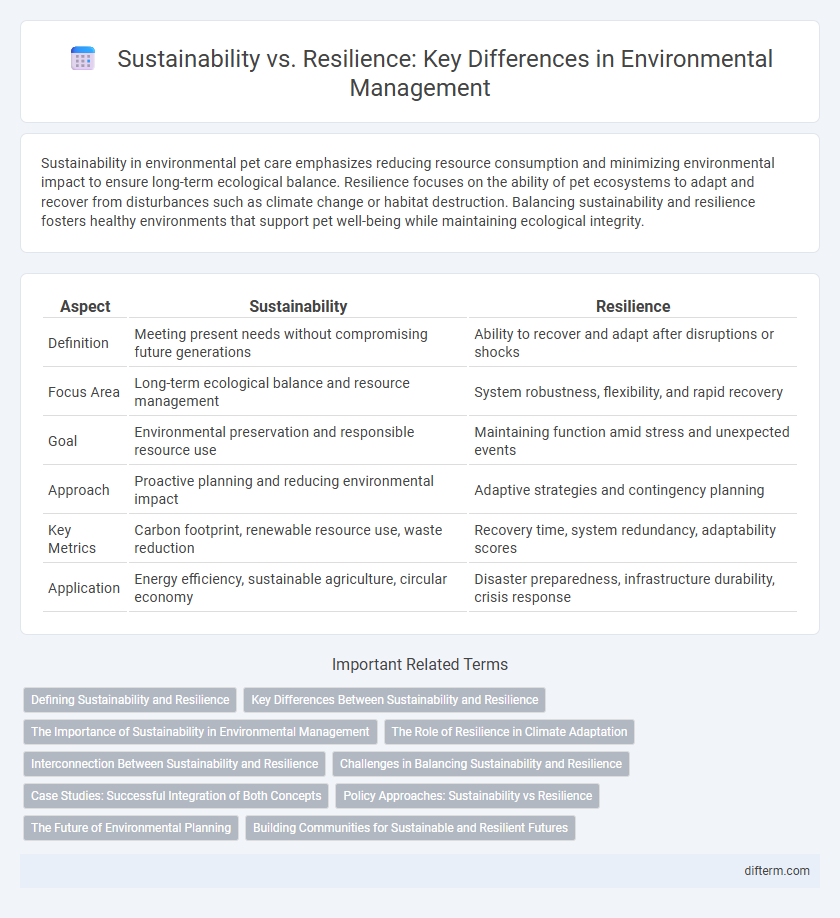Sustainability in environmental pet care emphasizes reducing resource consumption and minimizing environmental impact to ensure long-term ecological balance. Resilience focuses on the ability of pet ecosystems to adapt and recover from disturbances such as climate change or habitat destruction. Balancing sustainability and resilience fosters healthy environments that support pet well-being while maintaining ecological integrity.
Table of Comparison
| Aspect | Sustainability | Resilience |
|---|---|---|
| Definition | Meeting present needs without compromising future generations | Ability to recover and adapt after disruptions or shocks |
| Focus Area | Long-term ecological balance and resource management | System robustness, flexibility, and rapid recovery |
| Goal | Environmental preservation and responsible resource use | Maintaining function amid stress and unexpected events |
| Approach | Proactive planning and reducing environmental impact | Adaptive strategies and contingency planning |
| Key Metrics | Carbon footprint, renewable resource use, waste reduction | Recovery time, system redundancy, adaptability scores |
| Application | Energy efficiency, sustainable agriculture, circular economy | Disaster preparedness, infrastructure durability, crisis response |
Defining Sustainability and Resilience
Sustainability refers to the ability to maintain ecological balance by avoiding the depletion of natural resources to support long-term environmental health. Resilience emphasizes the capacity of ecosystems and communities to absorb disturbances, adapt, and recover from environmental stresses such as climate change and natural disasters. Both concepts are critical for ensuring the continued functionality and biodiversity of natural systems amid growing environmental challenges.
Key Differences Between Sustainability and Resilience
Sustainability emphasizes the capacity to maintain ecological balance by avoiding depletion of natural resources through practices like renewable energy use and waste reduction. Resilience focuses on the ability of ecosystems and communities to recover quickly from disturbances such as natural disasters or climate change impacts. While sustainability aims at long-term environmental harmony, resilience prioritizes adaptability and recovery speed in the face of environmental stressors.
The Importance of Sustainability in Environmental Management
Sustainability in environmental management ensures the long-term health of ecosystems by balancing resource use with conservation efforts, reducing carbon footprints, and promoting biodiversity. Sustainable practices mitigate climate change impacts, secure natural resources for future generations, and support economic growth without degrading environmental quality. Prioritizing sustainability strengthens ecosystem services, enhances community well-being, and fosters resilient adaptive capacities against environmental disturbances.
The Role of Resilience in Climate Adaptation
Resilience plays a critical role in climate adaptation by enabling ecosystems and communities to withstand and recover from extreme weather events and long-term environmental changes. Building resilience involves enhancing biodiversity, strengthening infrastructure, and promoting adaptive governance to reduce vulnerability to climate impacts. Integrating resilience strategies with sustainable practices ensures ongoing ecological balance while supporting human well-being amidst climate uncertainty.
Interconnection Between Sustainability and Resilience
Sustainability and resilience are deeply interconnected through their shared goal of maintaining ecosystem health and human well-being amid environmental changes. Sustainable practices reduce vulnerability by conserving natural resources, while resilience enhances the capacity to recover from disturbances like climate impacts or resource depletion. Together, they form a dynamic framework essential for long-term environmental stability and adaptive management.
Challenges in Balancing Sustainability and Resilience
Balancing sustainability and resilience presents challenges such as resource allocation conflicts, where long-term environmental goals may limit immediate adaptive capacity. Ecosystem complexity complicates efforts to design solutions that simultaneously reduce ecological footprints and withstand shocks like climate change. Policymakers often face trade-offs between promoting durable infrastructure and maintaining ecological integrity, hindering integrated approaches to environmental management.
Case Studies: Successful Integration of Both Concepts
Case studies from urban planning initiatives in Copenhagen and Singapore demonstrate successful integration of sustainability and resilience by implementing adaptive infrastructure that reduces carbon emissions while enhancing disaster preparedness. In agricultural practices, the system in Cuba combines soil regeneration techniques with water conservation, promoting both ecological balance and climate resilience. These examples highlight how aligning sustainable resource management with resilience strategies can foster long-term environmental stability and community well-being.
Policy Approaches: Sustainability vs Resilience
Policy approaches to environmental management increasingly differentiate between sustainability, which emphasizes long-term resource conservation and reducing ecological footprints, and resilience, which prioritizes adaptive capacity to withstand and recover from environmental shocks. Sustainability policies often focus on emission reductions, renewable energy adoption, and habitat preservation, while resilience frameworks promote infrastructure reinforcement, disaster preparedness, and ecosystem restoration. Integrating both approaches enhances comprehensive environmental governance, ensuring ecological balance alongside socio-economic adaptability in the face of climate change.
The Future of Environmental Planning
Sustainability in environmental planning emphasizes long-term resource management to reduce ecological footprints and preserve biodiversity. Resilience focuses on the ability of ecosystems and communities to adapt and recover from environmental shocks such as climate change and natural disasters. Integrating sustainability and resilience creates robust strategies that ensure both the protection of natural systems and the capacity to withstand future environmental challenges.
Building Communities for Sustainable and Resilient Futures
Building communities for sustainable and resilient futures requires integrating environmental stewardship with adaptive capacity to withstand climate impacts. Emphasizing sustainable resource management ensures long-term ecological balance while fostering resilience through social cohesion and infrastructure robustness. Enhancing local knowledge and collaboration accelerates recovery and supports continuous improvement in community well-being and environmental health.
sustainability vs resilience Infographic

 difterm.com
difterm.com